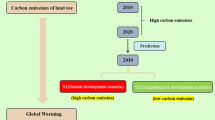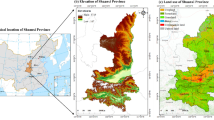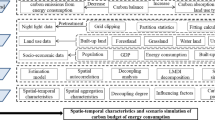Abstract
Land use and land cover (LULC) will cause large flows of carbon sources and sinks. As the world’s largest carbon emitter with a complicated LULC, China’s carbon emissions have profound implications for its ecological environment and future development. In this paper, we account for the land-use changes and carbon emissions of 30 Chinese provinces and cities in China from 2000 to 2020. Furthermore, the spatial correlation of carbon emissions among the study areas is explored. Four typical regions with spatial association (Beijing, Hebei, Sichuan, and Anhui) are selected, and their land-use change trends in 2025 and 2030 are simulated to predict the total carbon emissions in the future. The results show that the distribution of land-use in China is mainly cultivated and woodland, but the growth of urban built-up (UBL) land area indirectly leads to the continuous increase of carbon emissions. Total carbon emissions have increased over the past two decades, albeit at a slower growth rate, with some provinces experiencing no further growth. In the typical regional carbon emission simulation, it is found that the carbon emissions of the four provinces would show a downward trend in the future. The main reason is the reduction in indirect carbon emissions from fossil energy in UBL, while the other part is the influx of carbon sinks due to grassland, woodland, etc. We recommended that future carbon reduction measures should focus and prioritize controlling fossil energy and mitigating carbon emissions from UBL. Simultaneously, the significant contribution of forests and other land types as carbon sinks should be acknowledged to better implement China’s carbon neutral commitment.









Similar content being viewed by others
Data availability
The datasets used and/or analyzed during the current study are available from the corresponding author on reasonable request.
References
Brovkin V, Boysen L, Arora VK et al (2013) Effect of anthropogenic land-use and land-cover changes on climate and land carbon storage in CMIP5 projections for the twenty-first century. J Clim 26(18):6859–6881
Chuai XW, Huang XJ, Zheng ZQ (2011) Impacts of land use change on carbon storage of terrestrial ecosystem in Jiangsu province. J Res Sci 33:1932–1939
Chuai X, Huang X, Wang W et al (2015) Land use, total carbon emissions change and low carbon land management in Coastal Jiangsu, China. J Clean Prod 103:77–86
Dietz J, Treydte AC, Lippe M (2023) Exploring the future of Kafue National Park, Zambia: Scenario-based land use and land cover modelling to understand drivers and impacts of deforestation. Land Use Policy 126:106535. https://doi.org/10.1016/j.landusepol.2023.106535
Dong F, Dai YJ, Zhang SN et al (2019) Can a carbon emission trading scheme generate the Porter effect? Evidence from pilot areas in China. Sci Total Environ 653:565–577
Field, Behrenfeld, Randerson et al (1998) Primary production of the biosphere: integrating terrestrial and oceanic components. Science (new York, n.y.) 281(5374):237–240
Guo X, Chuai X, Huang X (2019) A land use/land cover based green development study for different functional regions in the Jiangsu Province, China. Int J Environ Res Public Health 16(7):1277. https://doi.org/10.3390/ijerph16071277
Han X, Yu J, Xia Y et al (2021) Spatiotemporal characteristics of carbon emissions in energy-enriched areas and the evolution of regional types. Energy Rep 7:7224–7237
He CY, Zhang D, Huang QX et al (2016) Assessing the potential impacts of urban expansion on regional carbon storage by linking the LUSD-urban and InVEST models. Environ Model Softw 75:44–58
Hong CP, Burney JA, Pongratz J et al (2021) Global and regional drivers of land-use emissions in 1961–2017. Nature 589(7843):554
Houghton RA, Hackler JL (2003) Sources and sinks of carbon from land-use change in China. Global Biogeochem Cycles 17(2):1034. https://doi.org/10.1029/2002GB001970
Houghton RA (2003) Revised estimates of the annual net flux of carbon to the atmosphere from changes in land use and land management 1850–2000. Tellus B: Chem Phys Meteorol 55(2):378–390. https://doi.org/10.3402/tellusb.v55i2.16764
Huang HZ, Jia JS, Zhang ZX (2023) Spatiotemporal pattern evolution and influence factors of land-use carbon emissions in counties, Jiangxi Province. Acta Ecol Sin 43(20):8390–8403. https://doi.org/10.20103/j.stxb.202211293454
IPCC Climate Change (2022) Impacts, adaptation, and vulnerability. contribution of working group II to the sixth assessment report of the intergovernmental panel on climate change.[Pörtner H-O, Roberts DC, Tignor M, Poloczanska ES, Mintenbeck K, Alegría A, Craig M, Langsdorf S, Löschke S, Möller V, Okem A, Rama B (eds.)]. Cambridge University Press. Cambridge University Press, Cambridge, UK and New York, NY, USA, pp. 3056. https://doi.org/10.1017/9781009325844. .
Jung M et al (2012) Global patterns of land-atmosphere fluxes of carbon dioxide, latent heat, and sensible heat derived from eddy covariance, satellite, and meteorological observations. J. Geophys. Res. 117:G04011. https://doi.org/10.1029/2012JG002190
Lai L, Huang XJ, Yang H et al (2016) Carbon emissions from land-use change and management in China between 1990 and 2010. Sci Adv 2(11):e1601063. https://doi.org/10.1126/sciadv.1601063
Le Quere C, Raupach MR, Canadell JG et al (2009) Trends in the sources and sinks of carbon dioxide. Nat Geosci 2(12):831–836
Li H, Zhao Y, Wang S et al (2020) Spatial-temporal characteristics and drivers of the regional residential CO2 emissions in China during 2000–2017. J Clean Prod 276:124116. https://doi.org/10.1016/j.jclepro.2020.124116
Li M, Zhang YF, Liu HC (2022a) Carbon neutrality in Shanxi Province: scenario simulation based on LEAP and CA-Markov models. Sustainability 14(21):13808. https://doi.org/10.3390/su142113808
Li S, Cao Y, Liu J et al (2022b) Assessing spatiotemporal dynamics of land use and cover change and carbon storage in China’s ecological conservation pilot zone: a case study in Fujian Province. Remote Sens 14(16):4111. https://doi.org/10.3390/rs14164111
Liang X, Guan QF, Clarke KC et al (2021a) Understanding the drivers of sustainable land expansion using a patch-generating land use simulation (PLUS) model: a case study in Wuhan. China. Comput Environ Urban Syst 85:101569. https://doi.org/10.1016/j.compenvurbsys.2020.101569
Liang Y, Hashimoto S, Liu L (2021b) Integrated assessment of land-use/land-cover dynamics on carbon storage services in the Loess Plateau of China from 1995 to 2050. Ecol Ind 120:106939. https://doi.org/10.1016/j.ecolind.2020.106939
Lin Q, Zhang L, Qiu B et al (2021) Spatiotemporal analysis of land use patterns on carbon emissions in China. Land 10(2):141. https://doi.org/10.3390/land10020141
Lorenz R, Pitman AJ (2014) Effect of land-atmosphere coupling strength on impacts from Amazonian deforestation. Geophys Res Lett 41(16):5987–5995
Luyssaert S, Schulze ED, Borner A et al (2008) Old-growth forests as global carbon sinks. Nature 455(7210):213–215
Mallick J, Almesfer MK, Alsubih M et al (2022) Estimating carbon stocks and sequestration with their valuation under a changing land use scenario: a multi-temporal research in Abha City. Saudi Arabia. Front Ecol Evol 10:905799. https://doi.org/10.3389/fevo.2022.905799
Molotoks A, Stehfest E, Doelman J et al (2018) Global projections of future cropland expansion to 2050 and direct impacts on biodiversity and carbon storage. Glob Change Biol 24(12):5895–5908
Pechanec V, Purkyt J, Benc A et al (2018) Modelling of the carbon sequestration and its prediction under climate change. Eco Inform 47:50–54
Piao SL, Fang JY, Ciais P et al (2009) The carbon balance of terrestrial ecosystems in China. Nature 458(7241):1009-U82
Smith P, Martino D, Cai Z et al (2008) Greenhouse gas mitigation in agriculture. Philos Trans R Soc B-Biol Sci 363(1492):789–813
Su YX, Chen XZ, Li Y et al (2014) China’s 19-year city-level carbon emissions of energy consumptions, driving forces and regionalized mitigation guidelines. Renew Sustain Energy Rev 35:231–243
Tao Y, Li F, Wang R et al (2015) Effects of land use and cover change on terrestrial carbon stocks in urbanized areas: a study from Changzhou, China. J Clean Prod 103:651–657
Wang L, Ma D, Chen W (2014) Future CO2 emissions allowances and inequality assessment under different allocation regimes. Energy Procedia 61:523–526
Wang CY, Myint SW (2016) Environmental concerns of deforestation in Myanmar 2001–2010. Remote Sens 8(9):728. https://doi.org/10.3390/rs8090728
Yang J, Huang X (2021) The 30 m annual land cover dataset and its dynamics in China from 1990 to 2019. Earth Syst Sci Data 13(8):3907–3925
Yang X, Jin X, Xiang X et al (2018) Carbon emissions induced by farmland expansion in China during the past 300 years. Sci China Earth Sci 62(2):423–437
Yang J, Li Y, Hay I et al (2019) Decoding national new area development in China: toward new land development and politics. Cities 87:114–120
Zhang L, Lin X, Xiao Y et al (2023) Spatial and structural characteristics of the ecological network of carbon metabolism of cultivated land based on land use and cover change: a case study of Nanchang, China. Environ Sci Pollut Res Int 30(11):30514–30529
Zhang DJ, Ge WY, Zhang Y (2020) Evaluating the vegetation restoration sustainability of ecological projects: a case study of Wuqi county in China. J Clean Prod 264:121750. https://doi.org/10.1016/j.jclepro.2020.121751
Zhao C, Liu Y, Yan Z (2023) Effects of land-use change on carbon emission and its driving factors in Shaanxi Province from 2000 to 2020. Environ Sci Pollut Res Int 30(26):68313–68326
Funding
This research was supported by the National Natural Science Foundation of China (Grant 41971313); the National Natural Science Foundation of China (Grant 42271411); Research Project on Monitoring and Early Warning Technologies for Implementation of Land Use Planning in Guangzhou City (2020B0101130009); Open Fund of Key Laboratory of Urban Land Resources Monitoring and Simulation, Ministry of Natural Resources [No. KF-2022-07-021].
Author information
Authors and Affiliations
Contributions
Yuxiang Cheng: Writing original draft, conceptualization, funding acquisition, project administration, formal analysis, and supervision. Yuqi Tang: writing original draft, methodology, literature review, data curation, visualization, and supervision. Bin Zou: writing, review, editing, visualization, and validation. Huihui Feng: resources, data curation, and supervision.
Corresponding author
Ethics declarations
Competing interests
The authors declare no competing interests.
Additional information
Responsible Editor: V.V.S.S. Sarma
Publisher's Note
Springer Nature remains neutral with regard to jurisdictional claims in published maps and institutional affiliations.
Rights and permissions
Springer Nature or its licensor (e.g. a society or other partner) holds exclusive rights to this article under a publishing agreement with the author(s) or other rightsholder(s); author self-archiving of the accepted manuscript version of this article is solely governed by the terms of such publishing agreement and applicable law.
About this article
Cite this article
Cheng, Y., Tang, Y., Zhou, B. et al. Spatiotemporal analysis of national carbon emission and regional carbon simulation in China. Environ Sci Pollut Res 31, 10702–10716 (2024). https://doi.org/10.1007/s11356-023-31817-6
Received:
Accepted:
Published:
Issue Date:
DOI: https://doi.org/10.1007/s11356-023-31817-6




